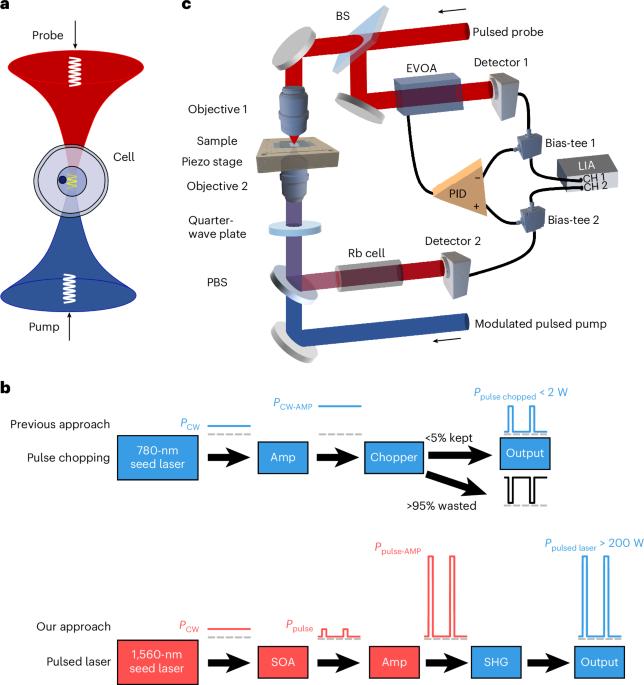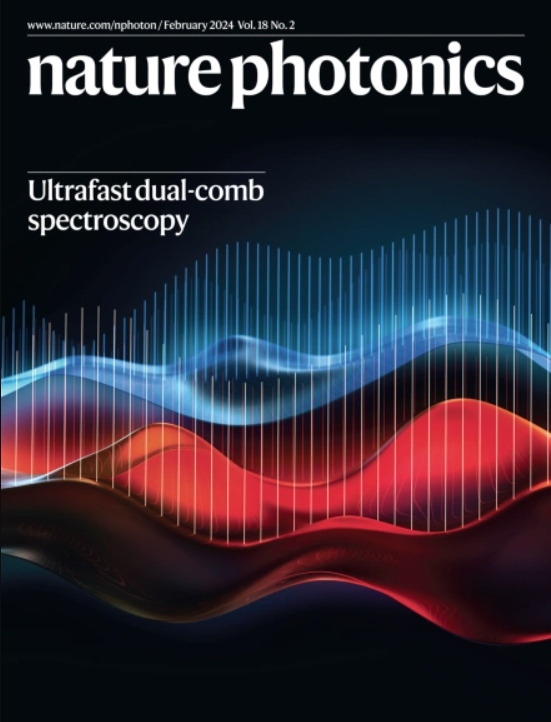峰值功率780 nm脉冲激光系统的受激布里渊散射显微镜
IF 32.9
1区 物理与天体物理
Q1 OPTICS
引用次数: 0
摘要
受激布里渊散射显微镜使全光学,非接触,高空间分辨率的机械成像具有高特异性。准连续波受激布里渊散射的最新进展大大降低了所需的激光功率。然而,像素停留时间仍然限制在20 ms,并且在不影响分辨率,精度或特异性的情况下进一步减少是具有挑战性的。在这里,我们通过开发一种工作在780 nm的倍频脉冲光纤激光系统来解决这一限制,提供267 W的峰值功率。为了减轻放大光纤激光器固有的高强度噪声,我们实现了一种基于自动平衡检测的高性能降噪系统。因此,我们实现了像素停留时间短至200µs的全光谱采集,这比以前的受激布里因散射实现快了两个数量级,并保持了30 mW的平均功率。我们展示了活单细胞、类器官、斑马鱼幼虫和卵巢卵泡的亚细胞细节的高速、高特异性和高灵敏度布里louin成像。此外,我们捕获了秀丽隐杆线虫早期胚胎发育过程中快速细胞分裂的体内生物力学动力学。本文章由计算机程序翻译,如有差异,请以英文原文为准。


Stimulated Brillouin scattering microscopy with a high-peak-power 780-nm pulsed laser system
Stimulated Brillouin scattering microscopy enables all-optical, non-contact, high-spatial-resolution mechanical imaging with high specificity. Recent advances in quasi-continuous-wave stimulated Brillouin scattering have substantially reduced the required laser power. However, the pixel dwell time remains limited to 20 ms, and further reductions without compromising resolution, precision or specificity are challenging. Here we address this limitation by developing a frequency-doubled pulsed fibre laser system operating at 780 nm, delivering a peak power of 267 W. To mitigate the high-intensity noise intrinsic to amplified fibre lasers, we implement a high-performance noise cancellation system based on auto-balanced detection. As a result, we achieve a pixel dwell time as short as 200 µs for full spectral acquisition, which is two orders of magnitude faster than previous stimulated Brillouin scattering implementations, and maintain an average power of 30 mW. We demonstrate high-speed, high-specificity and high-sensitivity Brillouin imaging of live single cells, organoids, zebrafish larvae and ovarian follicles with subcellular details. Furthermore, we capture the in vivo biomechanical dynamics of rapid cell divisions during the early embryo development of Caenorhabditis elegans in a living worm. A high-peak-power low-duty-cycle pulsed fibre laser enables stimulated Brillouin scattering microscopy with pixel dwell times as low as 0.2 ms and spatial resolution as low as 500 nm and 2 μm in the lateral and axial directions, respectively.
求助全文
通过发布文献求助,成功后即可免费获取论文全文。
去求助
来源期刊

Nature Photonics
物理-光学
CiteScore
54.20
自引率
1.70%
发文量
158
审稿时长
12 months
期刊介绍:
Nature Photonics is a monthly journal dedicated to the scientific study and application of light, known as Photonics. It publishes top-quality, peer-reviewed research across all areas of light generation, manipulation, and detection.
The journal encompasses research into the fundamental properties of light and its interactions with matter, as well as the latest developments in optoelectronic devices and emerging photonics applications. Topics covered include lasers, LEDs, imaging, detectors, optoelectronic devices, quantum optics, biophotonics, optical data storage, spectroscopy, fiber optics, solar energy, displays, terahertz technology, nonlinear optics, plasmonics, nanophotonics, and X-rays.
In addition to research papers and review articles summarizing scientific findings in optoelectronics, Nature Photonics also features News and Views pieces and research highlights. It uniquely includes articles on the business aspects of the industry, such as technology commercialization and market analysis, offering a comprehensive perspective on the field.
 求助内容:
求助内容: 应助结果提醒方式:
应助结果提醒方式:


